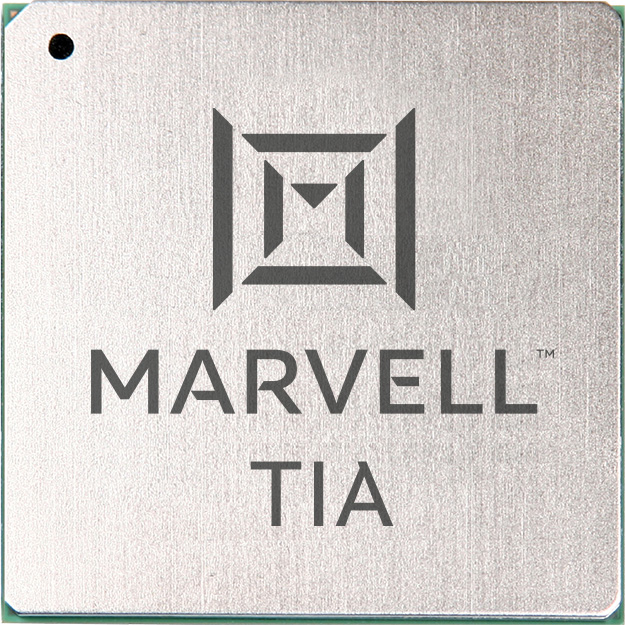- PRODUCTS
- COMPANY
- SUPPORT
- PRODUCTS
- BY TYPE
- BY MARKET
- COMPANY
- SUPPORT
Advancing Optics with a Hybrid Route to TIAs
Transimpedance amplifiers (TIAs) are one of the unsung heroes of the cloud and AI era.
At the recent OFC 2025 event in San Francisco, exhibitors demonstrated the latest progress on 1.6T optical modules featuring Marvell 200G TIAs. Recognized by multiple hyperscalers for its superior performance, Marvell 200G TIAs are becoming a standard component in 200G/lane optical modules for 1.6T deployments.

TIAs capture incoming optical signals from light detectors and transform the underlying data to be transmitted between and used by servers and processors in data centers and scale-up and scale-out networks. Put another way, TIAs allow data to travel from photons to electrons. TIAs also amplify the signals for optical digital signal processors, which filter out noise and preserve signal integrity.
And they are pervasive. Virtually every data link inside a data center longer than three meters includes an optical module (and hence a TIA) at each end. TIAs are critical components of fully retimed optics (FRO), transmit retimed optics (TRO) and linear pluggable optics (LPO), enabling scale-up servers with hundreds of XPUs, active optical cables (AOC), and other emerging technologies, including co-packaged optics (CPO), where TIAs are integrated into optical engines that can sit on the same substrates where switch or XPU ASICs are mounted. TIAs are also essential for long-distance ZR/ZR+ interconnects, which have become the leading solution for connecting data centers and telecom infrastructure. Overall, TIAs are a must have component for any optical interconnect solution and the market for interconnects is expected to triple to $11.5 billion by 2030, according to LightCounting.
TIAs are now at a technical juncture. Today’s TIAs are designed for optical components and networks operating at 100G/lane. However, equipment and components for 200G/lane networks are beginning to emerge and are expected to see deployment starting in 2026-2027. At 100G/lane, TIAs are typically connected within the optical module using wire bonds. But at 200G/lane, wire bonds become a limiting factor – their parasitic effects degrade performance at these higher data rates. To address this, many in the industry are advocating for flip-chip technology. In a flip-chip design, the TIA connects directly through the top of the chip rather than routing through the circuit board, reducing signal loss and enabling greater bandwidth.
Flip chip connections, however, require specialized circuit boards and other components that add cost and development time. The accompanying photodetectors also need to be flip-chipped onto dedicated substrates.
In its latest TIAs for 200G/lane, Marvell has taken a middle road, deploying flip chips for RF connections, where the additional performance and bandwidth have an impact, while keeping wire bond connections where the gains would be more minimal. In the flip-chip connections, the photodetectors are flipped and mounted directly on the TIA input pads. The output pads of the TIAs are instead wire bonded. This approach maximizes performance with the least cost.
The advanced and innovative TIA structure from Marvell, also known in the industry as hybrid or 2.5D, has pioneered 200G/lane developments and has now become a benchmark structure for TIAs at 200G, ensuring reduced costs, improved yield, improved crosstalk performance, and improved signal integrity. The photodetectors ecosystem has also now converged around Marvell 200G TIAs.
With Marvell 2.5D and flip chip TIAs, module vendors and hyperscalers can achieve unprecedented performance in the bit error ratio floor and sensitivity at 200G/lane, which has been observed in an apples-to-apples environment and end application tests.
Marvell best-in-class 200G TIAs can be used in all pluggable applications—from FRO to TRO and LPO— and can be integrated in optical engines to suit the latest advancements in CPO-enabled XPU designs.
Marvell has components, integration, packaging and system know-how and a solid roadmap to enable every aspect of optical interconnect solutions.
Marvell 200G TIAs are well positioned to gain market share in data centers, where Marvell 100G TIAs and laser drivers already hold a significant presence.
###
Marvell and the M logo are trademarks of Marvell or its affiliates. Please visit www.marvell.com for a complete list of Marvell trademarks. Other names and brands may be claimed as the property of others.
This blog contains forward-looking statements within the meaning of the federal securities laws that involve risks and uncertainties. Forward-looking statements include, without limitation, any statement that may predict, forecast, indicate or imply future events or achievements. Actual events or results may differ materially from those contemplated in this blog. Forward-looking statements are only predictions and are subject to risks, uncertainties and assumptions that are difficult to predict, including those described in the “Risk Factors” section of our Annual Reports on Form 10-K, Quarterly Reports on Form 10-Q and other documents filed by us from time to time with the SEC. Forward-looking statements speak only as of the date they are made. Readers are cautioned not to put undue reliance on forward-looking statements, and no person assumes any obligation to update or revise any such forward-looking statements, whether as a result of new information, future events or otherwise.
Tags: Optical Connectivity, Optical Interconnect, data center interconnect, high speed optical connectivity, hig speed optics
Recent Posts
- Custom Silicon: A Sea Change for Semiconductors
- Marvell Named to America’s Most Responsible Companies 2026 List
- 5 Times More Queries per Second: What CXL Compute Accelerators Can Do for AI
- Marvell Makes Inaugural 100 Best Companies in Southeast Asia List
- Marvell Earns “Fittest Firm” Title in Silicon Valley Turkey Trot for 10th Consecutive Year
Archives
Categories
- 5G (10)
- AI (46)
- Cloud (19)
- Coherent DSP (11)
- Company News (107)
- Custom Silicon Solutions (9)
- Data Center (69)
- Data Processing Units (21)
- Enterprise (24)
- ESG (10)
- Ethernet Adapters and Controllers (11)
- Ethernet PHYs (3)
- Ethernet Switching (41)
- Fibre Channel (10)
- Marvell Government Solutions (2)
- Networking (43)
- Optical Modules (19)
- Security (6)
- Server Connectivity (32)
- SSD Controllers (6)
- Storage (23)
- Storage Accelerators (4)
- What Makes Marvell (47)
Copyright © 2025 Marvell, All rights reserved.
- Terms of Use
- Privacy Policy
- Contact

